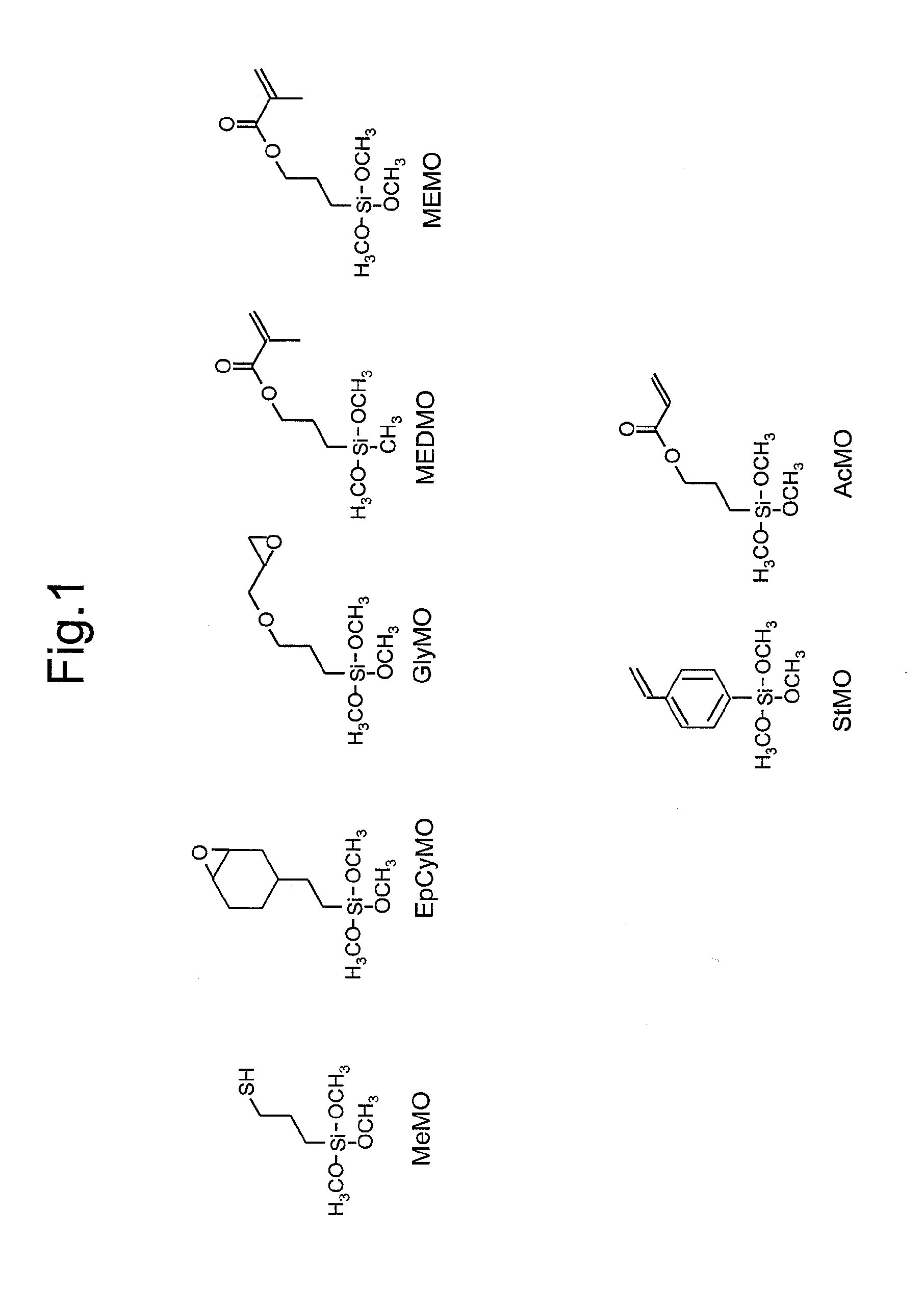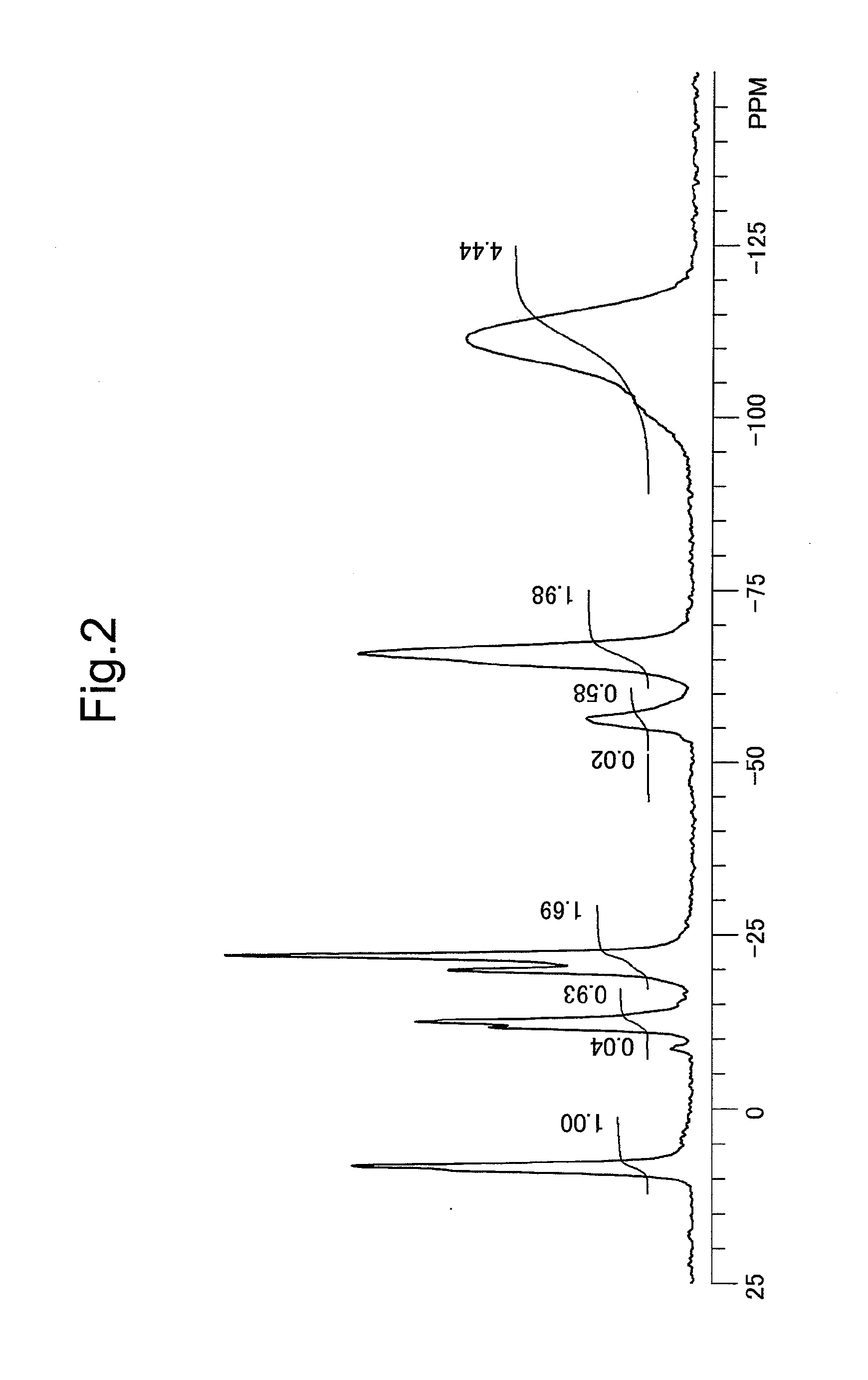Photosensitive silicone resin composition
- Summary
- Abstract
- Description
- Claims
- Application Information
AI Technical Summary
Benefits of technology
Problems solved by technology
Method used
Image
Examples
example 1
[0226]25.76 g (0.111 mol) of 3-methacryloxypropyl(methyl) dimethoxysilane (abbreviated as MEDMO), 15.10 g (0.111 mol) of methyltrimethoxysilane (abbreviated as MTMS) and 10 g of ethanol were placed in a 500 mL, eggplant-shaped flask and stirred. 19.96 g of distilled water and 0.004 g of 10% hydrochloric acid were placed in a separate container and after mixing, the mixture was dropped into the aforementioned 500 mL eggplant-shaped flask over the course of 10 minutes using a dropping funnel. Following completion of dropping, a cooling tube was attached and the contents were refluxed for 2 hours at 80° C. in the presence of flowing nitrogen using an oil bath to obtain Reaction Liquid 1 containing the polysiloxane compound (a).
[0227]50 g of PL-1SL (Fuso Chemical Co., Ltd., water-dispersed silica particles having a mean primary particle diameter of 12 nm and concentration of 20% by weight) (silica particles (b)) and 50 g of ethanol were placed in a 500 mL eggplant-shaped flask and stirr...
example 2
[0231]15.46 g (0.067 mol) of MEDMO, 9.06 g (0.067 mol) of MTMS and 10 g of ethanol were placed in a 500 mL, eggplant-shaped flask and stirred. 11.97 g of distilled water and 0.004 g of 10% hydrochloric acid were placed in a separate container and after mixing, the mixture was dropped into the aforementioned 500 mL eggplant-shaped flask over the course of 10 minutes using a dropping funnel. Following completion of dropping, a cooling tube was attached and the contents were refluxed for 2 hours at 80° C. in the presence of flowing nitrogen using an oil bath to obtain Reaction Liquid 2 containing the polysiloxane compound (a).
[0232]110 g of PL-1SL (silica particles (b)) and 100 g of ethanol were placed in a 500 mL eggplant-shaped flask and stirred. Continuing, the Reaction Liquid 2 cooled to room temperature was then dropped into the aforementioned eggplant-shaped flask over the course of 20 minutes using a dropping funnel and stirred for 30 minutes at room temperature. Following stirr...
example 3
[0236]5.88 g (0.025 mol) of MEDMO, 7.54 g (0.030 mol) of 3-methacryloxypropyltrimethoxysilane (abbreviated as MEMO), 6.67 g (0.035 mol) of cyclohexylmethyldimethoxysiloxane (abbreviated as CyMDMS) and 10 g of ethanol were placed in a 500 mL, eggplant-shaped flask and stirred. 7.65 g of distilled water and 0.004 g of 10% hydrochloric acid were placed in a separate container and after mixing, the mixture was dropped into the aforementioned 500 mL eggplant-shaped flask over the course of 10 minutes using a dropping funnel. Following completion of dropping, a cooling tube was attached and the contents were refluxed for 2 hours at 80° C. in the presence of flowing nitrogen using an oil bath to obtain Reaction Liquid 3 containing the polysiloxane compound (a).
[0237]120 g of PL-1SL (silica particles (b)) and 100 g of ethanol were placed in a 500 mL eggplant-shaped flask and stirred. Continuing, the Reaction Liquid 3 cooled to room temperature was then dropped into the aforementioned eggpla...
PUM
| Property | Measurement | Unit |
|---|---|---|
| Temperature | aaaaa | aaaaa |
| Temperature | aaaaa | aaaaa |
| Temperature | aaaaa | aaaaa |
Abstract
Description
Claims
Application Information
 Login to View More
Login to View More - R&D
- Intellectual Property
- Life Sciences
- Materials
- Tech Scout
- Unparalleled Data Quality
- Higher Quality Content
- 60% Fewer Hallucinations
Browse by: Latest US Patents, China's latest patents, Technical Efficacy Thesaurus, Application Domain, Technology Topic, Popular Technical Reports.
© 2025 PatSnap. All rights reserved.Legal|Privacy policy|Modern Slavery Act Transparency Statement|Sitemap|About US| Contact US: help@patsnap.com



